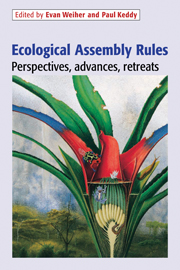Book contents
- Frontmatter
- Contents
- List of Contributors
- Introduction: The scope and goals of research on assembly rules
- Part I The search for meaningful patterns in species assemblages
- 1 The genesis and development of guild assembly rules
- 2 Ruling out a community assembly rule: the method of favored states
- 3 Community structure and assembly rules: confronting conceptual and statistical issues with data on desert rodents
- 4 Introduced avifaunas as natural experiments in community assembly
- 5 Assembly rules in plant communities
- 6 Assembly rules at different scales in plant and bird communities
- 7 Impact of language, history and choice of system on the study of assembly rules
- Part II Other perspectives on community assembly
- Index
5 - Assembly rules in plant communities
Published online by Cambridge University Press: 04 September 2009
- Frontmatter
- Contents
- List of Contributors
- Introduction: The scope and goals of research on assembly rules
- Part I The search for meaningful patterns in species assemblages
- 1 The genesis and development of guild assembly rules
- 2 Ruling out a community assembly rule: the method of favored states
- 3 Community structure and assembly rules: confronting conceptual and statistical issues with data on desert rodents
- 4 Introduced avifaunas as natural experiments in community assembly
- 5 Assembly rules in plant communities
- 6 Assembly rules at different scales in plant and bird communities
- 7 Impact of language, history and choice of system on the study of assembly rules
- Part II Other perspectives on community assembly
- Index
Summary
Introduction
‘To do science is to search for repeated patterns’ (MacArthur, 1972). Therefore, to do community ecology must be to search for repeated community patterns. Two basic kinds of community pattern can be envisaged, with different causes:
(a) Environmentally mediated patterns, i.e., correlations between species due to their shared or opposite responses to the physical environment. Ecologists have long tried ‘to find out which species are commonly associated together upon similar habitats’ (Warming, 1909). Modern methods allow more subtle questions to be examined, such as the shape of environmental responses (e.g., Bio et al., 1998), the niche widths (e.g., Diaz et al., 1994), and how repeatable the associations of species are (e.g., Wilson et al., 1996c). However, the simple existence of environmentally mediated patterns is now too obvious to need demonstrating; Warming (1909) described it as ‘this easy task’.
(b) Assembly rules, i.e., patterns due to interactions between species, such as competition. These patterns, when we can find them, are fascinating evidence that competition, allelopathy, facilitation, mutualism, and all the other biotic interactions that we know about in theory, actually affect communities in the real world.
Of course, to make this distinction, it has to be known what processes have caused each pattern – physical environment or biotic interactions – but that is our task as community ecologists. Both types of process may occur.
Information
- Type
- Chapter
- Information
- Ecological Assembly RulesPerspectives, Advances, Retreats, pp. 130 - 164Publisher: Cambridge University PressPrint publication year: 1999
Accessibility standard: Unknown
- 92
- Cited by
